Ruger Mini-14
The Mini-14 is a lightweight semi-automatic rifle manufactured by Sturm, Ruger & Co. used by military personnel, law enforcement personnel, and civilians. A .223 caliber (5.56 mm) firearm is made in a number of variants, including: the Ranch Rifle (a basic, civilian variant), the Mini-14 GB, and the Mini Thirty, which is chambered for 7.62×39mm.
| Mini-14 | |
|---|---|
 The Mini-14 GB (Government Bayonet) | |
| Type |
|
| Place of origin | United States |
| Service history | |
| Used by | See Users |
| Wars | Rhodesian Bush War[1] The Troubles[2] |
| Production history | |
| Designer | L. James Sullivan, William B. Ruger |
| Designed | 1967–1973 |
| Manufacturer | Sturm, Ruger & Co. |
| Produced | 1973–present |
| Variants | See Variants |
| Specifications | |
| Mass | 6 lb 6 oz (2.90 kg) |
| Length | 37.25 in (946 mm) |
| Barrel length | 13 in (330 mm) to 22.0 in (559 mm) |
| Cartridge | .223 Remington 5.56×45mm NATO .300 AAC Blackout 7.62×39mm |
| Action | Gas-operated, rotating bolt |
| Rate of fire | 750 rpm (Full-auto rate-of-fire for AC-556 model only)[3] |
| Muzzle velocity | 3240 ft/s (990 m/s) |
| Feed system | 5- to 30-round factory box magazine. |
| Sights | Iron sights |
History and design
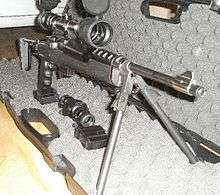
Introduced in 1973 by Sturm, Ruger & Co.[4], the Mini-14 resembles a smaller version of the military M14 rifle.[5] Designed by L. James Sullivan[6] and William B. Ruger, it incorporated numerous innovations and cost-saving engineering changes. The Mini-14 rifle has an investment-cast, heat-treated receiver and is mechanically similar to the M1 rifle, with a self-cleaning, fixed-piston gas system.[7][8]
Initial rifles were produced with a complex, exposed bolt hold-open device with no button for manual engagement. Stocks were somewhat angular and heat shields were made of wood. These rifles, with serial number prefixes before 181, were tooled and redesigned with a new stock, new bolt hold-open mechanism, and other small changes.[9]
The original Mini-14 rifle had a rear aperture sight with large protective wings and no integral scope bases. In 1982, Ruger introduced the Ranch Rifle with an integral scope base on the receiver, a new folding-aperture rear sight and factory scope rings.
In 1987, Ruger introduced the Mini Thirty rifle chambered for the Russian 7.62×39mm cartridge. At the time, large quantities of surplus military ammunition were being imported into the United States at rock-bottom prices. Also, the 7.62×39mm is ballistically similar to the .30-30 Winchester cartridge. As a result, the Mini Thirty proved to be an effective deer rifle.
In 2003, the design was overhauled to improve accuracy, update the styling, and reduce production costs. The standard Mini-14 was discontinued and the name became the family name for all Mini-14 type rifles. As of 2005, all Mini-14 type rifles are based on the Ranch Rifle design, with integral scope bases, a non-folding ghost ring aperture rear sight, and a winged front sight similar to that used on the Ruger Police Carbine.[9] They have serial numbers beginning with 580 and are sometimes referred to as 580-series Ranch Rifles.[10] They also have a new modified gas system designed to reduce barrel vibration[9] and can shoot two-inch groups at 100 yards, which is 2 MOA (minute of angle) accuracy.[10]
Around 2007 or 2008, Ruger added a heavier, larger-diameter barrel visibly tapered from gas block to muzzle. These changes combined with tighter tolerances result in greater potential accuracy.[8]
All Mini-14 type rifles are available in stainless steel or blued finish with hardwood, synthetic, or laminated stocks with 16.12-inch (409 mm) or 18.5-inch (470 mm) barrels.[10]
Variants
Ranch Rifle
The Ranch Rifle is a basic model offered in a wood or synthetic rifle stock paired with a blued or stainless steel receiver and a standard 18.5" tapered barrel (1:9" RH twist rate). These rifles feature an adjustable ghost ring rear sight and winged front sight, and they are sold with a detachable scope rail mount and a choice of two 20-round or 5-round detachable box magazines to comply with some U.S. states and other countries which have laws restricting magazine capacity. All models are chambered in both .223 Remington and 5.56×45mm NATO ammunition except the Target Rifle variant (which is .223 only).[9]
Target Rifle
Introduced in 2007,[11] the "Target Rifle" version has a 22-inch (560 mm) cold hammer-forged heavy barrel, adjustable harmonic tuner with adjustable minute-of-angle accuracy, and either a laminated wood or Hogue overmolded synthetic stock.[12][13] The Target Rifle does not have iron sights but includes the standard scope rings and Picatinny rail mount.[13] It is designed for use with the .223 Remington round only; 5.56 NATO is not warranted by Ruger.[14]
Tactical Rifle
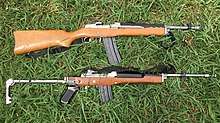
Introduced in 2009,[15] the "Tactical Rifle" is the newest variant, which includes the shorter 16.12" barrel with flash suppressor, and is available with a standard fixed stock/forend, or a collapsible ATI-brand stock with Picatinny rails. This model is chambered in both .223 Remington/5.56×45mm NATO[16] and .300 AAC Blackout as of 2015.[17]
Mini Thirty

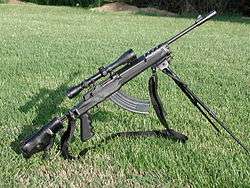
In 1987, Ruger began production of the Mini Thirty. The Mini Thirty is chambered for the Russian 7.62×39mm cartridge, used in the SKS and AK-47, as many states prohibit hunting of deer with calibers smaller than 6 mm (.243 in). The 7.62×39mm has ballistics similar to the well-known .30-30 Winchester.[18] The Mini Thirty is available with a 16.12" (Tactical Model) or 18.50" barrel having a twist rate of 1:10" RH, and is sold with two 20-round or 5-round box magazines.[19] Ruger does not currently produce 30-round Mini Thirty magazines. The Mini Thirty shares many of the same design and accessory options with those of the smaller caliber Mini-14 Ranch Rifle.
Mini Thirty Tactical Rifle
The "Mini Thirty Tactical Rifle" variant was introduced in 2010.[20] It closely mimics the Mini-14 Tactical Rifle variant, but in 7.62x39mm. It also has a shorter 16.12" barrel with flash suppressor, and is available with a standard fixed stock/forend, or a collapsible ATI-brand stock with Picatinny rails.
Government models
Mini-14 GB
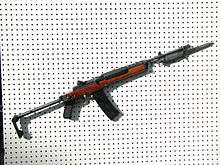
The Mini-14 GB ("government barrel") models feature either a pistol grip, side folding stock or a standard semi-pistol grip rifle stock, a 20 or 30-round magazine, bayonet lug, threaded barrel, and flash suppressor. Proof that GB stands for Government Barrel and not Government Bayonet can be seen in Ruger's new Tactical models and Ruger continuing to use "GB" which are catalogued for example KM-14/20GBCP. These models have no bayonet lug but do have the flash hider. Sales of the models with bayonet lug were intended only for law enforcement, military and private security markets, and could only be found in Ruger's Law Enforcement Catalog. [21] However, many have entered the civilian market.[22]
AC-556
The AC-556 is a selective-fire version of the Mini-14 marketed for military and law enforcement use. The design incorporates a selector on the right/rear of the receiver to select either semi-automatic, 3-round burst, or full-automatic fire modes; the manual safety at the front of the trigger guard operates the same as a standard Mini-14. The front sight is winged and incorporates a bayonet lug. The 13-inch (330 mm) or 18-inch (460 mm) barrel incorporates a flash suppressor, which can be used to launch approved tear-gas and smoke rifle grenades. A folding stock was used on the AC-556F and AC-556K. The rifle came equipped with 20-round magazines and a 30-round version was available for a time. The AC-556 was dropped from production in 1999 and Ruger stopped offering service for the rifle in 2009.[23][24] By that time, some models became available for private civilian purchase in the NFA market.[25]
Mousqueton A.M.D
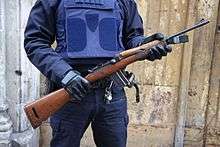
In France, the AC-556 is known as the Mousqueton A.M.D. where it was used by several governmental agencies within the French Interior Ministry: the Police Aux Frontières ("P.A.F."—Border Police), the Police Nationale Compagnies Républicaines de Sécurité (or "C.R.S."—Riot Control Brigade) and the Groupe d'Intervention de la Gendarmerie Nationale ("GIGN") special operations unit.[26][27] The A.M.D. come in two versions, the first has the standard Ruger aperture rear sight. On the other, the aperture rear sight has been completely removed and replaced with a tangent rear sight located on top of the barrel just forward of the receiver.
Straight-pull action
A small number of straight-pull only (a.k.a. bolt-action only) Mini-14 and Mini-30 rifles were manufactured for sale in the United Kingdom as a result of legislation which banned semi-automatic centerfire rifles in 1988.[28]
Other calibers and accessories
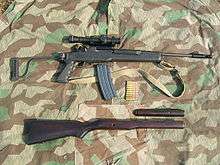
.jpg)
.222 Remington
Ruger produced a .222 Remington caliber model as of 1984.[29] Designated Mini-14/5R.222, these rifles were made mostly for the European market and were discontinued in the early 1980s.[30][31]
6.8 mm Remington
In 2007, Ruger began production of the Mini-6.8 utilizing the commercial 6.8mm Remington SPC cartridge.[32] However, they were discontinued in 2012 and are no longer listed in the Ruger catalog.
300 Blackout
In 2015 Ruger introduced the Mini-14 Tactical chambered in .300 AAC Blackout.[17]
Accessories
There are a wide range of aftermarket accessories available for the Mini-14 and Mini-30, including numerous stocks, magazines, weaver and Picatinny rail mounts.[9]
Users
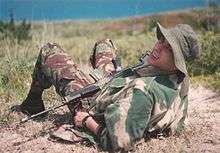
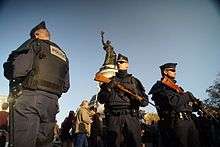
.svg.png)




.svg.png)

.svg.png)



Criminal use
The Ruger Mini-14 was used in several notable crimes:
- Robert Hansen, a prolific American serial killer active between 1971 and 1983, killed his victims with a Ruger Mini-14 and a knife.
- In 1983, Louis D. Hastings used a Ruger Mini-14 to kill six people in the small, isolated village of McCarthy, Alaska.
- In 1989, Gordon Kahl, his son Yorie, and friend Scott Faul used Ruger Mini-14 rifles in two bloody shootouts in separate times with the police.
- Darkley killings, Three men with at least one armed with a Ruger Mini-14 opened fire upon worshippers attending a church service at Mountain Lodge Pentecostal Church, killing three Protestant civilians and wounding seven. The attack was claimed by the "Catholic Reaction Force" a cover name for members of the Irish National Liberation Army in retaliation for murders of catholic civilians carried out by the Protestant Action Force.
- Michael Lee Platt used a Ruger Mini-14 in the 1986 FBI Miami shootout, which resulted in FBI agents and other American law enforcement agencies switching to more powerful, higher-capacity handguns, and stronger body armor.[55][56][57]
- In April 1987, William Bryan Cruse used a Ruger Mini-14, along with a 20-gauge Winchester shotgun & .357 Ruger Blackhawk revolver, in a shooting spree at two separate supermarkets.
- Joseph Schwab was a German tourist and spree killer who used a Ruger Mini-14 to murder five people in the Top End region of the Northern Territory and Western Australia in June 1987.
- Marc Lépine used a Ruger Mini-14 in the École Polytechnique Massacre, which resulted in the Canada Firearms Act, 1995[58][59] and new police response procedures.[60]
- Carel Johannes Delport used a Ruger Mini-14, along with a .357 Magnum revolver, in a shooting spree in Ladysmith, South Africa in 1992.
- Martin Peyerl used a Ruger Mini-14, along with a Colt Python and a Winchester Model 1866, in a killing spree in Bad Reichenhall, Germany in 1999.
- In the 2003 Lockheed Martin shooting, Douglas Williams was armed with a Ruger Mini-14 (alongside a Winchester 1200 12 -gauge shotgun), although it was not fired.
- Jan Molenaar used a Ruger Mini-14 in the Napier shootings in New Zealand.
- Anders Behring Breivik used a Ruger Mini-14 (along with a Glock 34) in the 2011 Norway attacks,[61] during which he fatally shot 69 people on an island summer camp and was further responsible for eight additional deaths in a bombing in Oslo, in what became Norway's deadliest attack since World War II.[62]
- Byron David Smith used a Ruger Mini-14 to fatally shoot two people during a home invasion in 2012. While the case sparked a debate on "castle doctrine" use, which allows a homeowner to defend their home with lethal force, he was convicted of the killings and received a life sentence.
- Rockne Warren Newell used a Ruger Mini-14, along with a .44 Magnum revolver, in the 2013 Ross Township Municipal Building shooting.
- Nathanial Lee Kangas used a Ruger Mini-14 to kill two Alaska State Troopers in Tanana, Alaska in 2014.
References
- "A BRITISH MERC, SOLDIER OF FORTUNE, AND A FIREFIGHT, Part One".
- "The Ruger Mini 14 in Military Use". Ruger Talk - The Community for Ruger Firearms Owners.
- Ian V. Hogg; John S. Weeks (2000). Military Small Arms of the 20th Century. Krause Publications. p. 295. ISBN 978-0-87341-824-9.
- Hogg, Ian (2000-02-10). Military Small Arms of the 20th Century. Krause Publications. ISBN 978-0-87341-824-9.
- Jack Lewis; Robert K. Campbell; David Steele (26 September 2007). The Gun Digest Book of Assault Weapons. Iola, Wisconsin: Gun Digest Books. pp. 87–89. ISBN 0-89689-498-3.
- Ezell, Virginia Hart (November 2001). "NDM Article - Focus on Basics, Urges Small Arms Designer". Archived from the original on October 8, 2006.
- Military Small Arms Of The 20th Century, 7th Edition, 2000 by Ian V. Hogg & John S. Weeks, p.295
- J. Guthrie. "The Mini Grows Up—Again". Rifle Shooter.
- Lewis, Jack (28 February 2011). "Today's Mini-14". Assault Weapons. Iola, Wisconsin: Gun Digest Books. pp. 128–130. ISBN 1-4402-2400-5.
- Sheetz, Brian (22 March 2016). "Five Reasons To Reconsider The Ruger Mini-14". American Rifleman.
- "STURM, RUGER & CO., INC. RIFLES: SEMI-AUTO, CENTERFIRE MINI-14 RANCH RIFLE". Blue Book of Gun Values. Retrieved 2016-11-07.
- "Ranch Rifle Target model with overmolded stock" (PDF). Ruger-firearms.com (Press release). Retrieved 2016-11-07.
- "Ruger® Mini-14® Target Rifle Autoloading Rifle Models". Ruger.com. Archived from the original on 2016-11-06.
- Dan Shideler (7 August 2011). Gun Digest 2012. Iola, Wisconsin: Gun Digest Books. pp. 439–440. ISBN 1-4402-1447-6.
- "STURM, RUGER & CO., INC. RIFLES: SEMI-AUTO, CENTERFIRE MINI-14 TACTICAL RIFLE FIXED STOCK". Blue Book of Gun Values. Retrieved 2016-11-07.
- Publishing, Skyhorse (1 November 2009). Shooter's Bible. Skyhorse Publishing Inc. p. 43. ISBN 978-1-60239-801-6.
- "Ruger Mini-14 Tactical Rifle Now Available in 300 AAC Blackout". Sturm, Ruger & Co., Inc. 2015-04-22. Retrieved 2017-02-21.
- Warner, Ken (1989). Gun Digest 1990: 44th Edition. DBI Books. p. 147. ISBN 978-0-87349-038-2.
Trajectories are identical according to Remington
- Shideler, Dan (28 February 2011). "The Hammer of Thor". Gun Digest Book of Deer Guns: Arms & Accessories for the Deer Hunter. Iola, Wisconsin: Gun Digest Books. pp. 42–43. ISBN 1-4402-2666-0.
- "Ruger Introduces Mini Thirty Tactical Rifle". Sturm, Ruger & Company, Inc. 2010-09-08. Retrieved 2017-02-21.
- Ramos, Joe (1982). The Mini-14 Exotic Weapons System. Boulder, Colorado: Paladin Press. ISBN 0873645278.
- Peterson, Phillip (30 September 2008). Gun Digest Buyer's Guide To Assault Weapons. Iola, Wisconsin: F+W Media. pp. 198–200. ISBN 978-1-4402-2444-7.
- "Ruger AC-556 Select Fire Military Rifle". 1 February 2013. Retrieved 2 August 2013.
- Chris Bishop; Tony Cullen; Ian Drury (1988). The Encyclopedia of World Military Weapons. Crescent Books. p. 246. ISBN 978-0-517-65341-8.
- "RUGER AC556: THE TOTALLY LEGAL, TOTALLY SELECT FIRE MINI 14 (VIDEO)". March 10, 2014. Retrieved April 24, 2020.
- Martin K.A. Morgan (January 9, 2015). "The Mousqueton A.M.D.— France's Mini-14". Retrieved January 12, 2015.
- "French Police Mini-14". January 11, 2015. Retrieved January 12, 2015.
- Bishop, Chris (1996). The Vital Guide to Combat Guns and Infantry Weapons. Airlife. p. 44. ISBN 978-1-85310-539-5.
- Brister, Bob (1984). "News from the 2 R's". Field & Stream. 88 (10): 110. ISSN 8755-8599. Retrieved 2 August 2013.
- Standard Catalog of Ruger Firearms. Jerry Lee. "F+W Media, Inc.", Dec 16, 2014. Antiques & Collectibles. page 78
- Wilson, Robert (10 November 2015). Ruger and His Guns: A History of the Man, the Company & Their Firearms. Skyhorse Publishing Company, Incorporated. p. 577. ISBN 978-1-5107-0926-3.
- Ramage, Ken; Sigler, Derrek (19 November 2008). Guns Illustrated 2009. Iola, Wisconsin: F+W Media, Inc. p. 146. ISBN 0-89689-673-0.
- Graham Williams (July 1, 1988). "NSW Declares Chemical War On Prisoners". Sydney Morning Herald. Archived from the original on 2015-04-02.
Other equipment includes [...] a Ruger .223 gas-operated, semi-automatic carbine (with a range of 2800 metres)
- "Ruger Mini-14". Bermudaregiment.bm. Archived from the original on 2016-03-04. Retrieved 2016-11-07.
- "Bermuda Regiment Fitness for Role Inspection". British Defence Staff. November 2005. Archived from the original on 2015-04-03.
- "Rifles worth $1.4m donated to Regiment | The Royal Gazette:Bermuda News". The Royal Gazette. Retrieved 2017-04-20.
- Aksoy, Kadir (4 December 2018). "Policia Civil - Rio de Janeiro". Retrieved 30 April 2020.
- Montes, Julio A. (May 2000). "Infantry Weapons of the Salvadoran Forces". Small Arms Review. Vol. 3 no. 8.
- Gander, Terry J.; Hogg, Ian V. Jane's Infantry Weapons 1995/1996. Jane's Information Group; 21 edition (May 1995). ISBN 978-0-7106-1241-0.
- "Summary of Development Training in 2007" (PDF). Hong Kong Correctional Services. 2007. Retrieved 20 April 2017.
- Soldier of Fortune magazine, Robert K Brown, 1980
- https://www.rtarf.mi.th/index.php/th/
- "Freedom of Information Request" (PDF). Police Service of Northern Ireland.
- "Surrey Constabulary: Part 4: A Policing Revolution: 1976–1992". Archived from the original on 2016-05-24. Retrieved 2017-04-20.
- Larry Celona (2002-07-04). "Terror-Wary NYPD testing new assault rifle". New York Post. Retrieved 2009-10-29.
- "NYPD boosts training after Mumbai attack". Associated Press & Taipei Times. 2009-02-17. Retrieved 2009-10-29.
- "Archived copy" (PDF). Archived from the original (PDF) on 2010-01-17. Retrieved 2009-12-24.CS1 maint: archived copy as title (link)
- "Archived copy" (PDF). Archived from the original (PDF) on 2011-07-21. Retrieved 2009-12-24.CS1 maint: archived copy as title (link)
- "Archived copy" (PDF). Archived from the original (PDF) on 2009-12-19. Retrieved 2009-12-24.CS1 maint: archived copy as title (link)
- "Agency Issue (Very Long)". Realpolice.net. Archived from the original on 2016-06-02. Retrieved 2016-11-07.
- "NC Correction News - May 1998 - DOP Firearms Training". Doc.state.nc.us. Retrieved 2016-11-07.
- Lewis, Jack (2007). "CQB Combat Training". Gun Digest Book of Assault Weapons (7 ed.). Iola, Wisconsin: Gun Digest Books. p. 134. ISBN 978-1-4402-2652-6. Retrieved 2 August 2013.
- Mike Ryan (2008). The Operators: Inside the World's Special Forces. p. 187. ISBN 1602392153.
- Hugh Milne (1987). Bhagwan: The God That Failed. St Martin's Press. p. 228. ISBN 0312001061.
- "FBI marks 30 years since infamous bloody Miami shootout". Retrieved 2016-09-25.
- "5 Gunfights That Changed Law Enforcement". Retrieved 2016-09-25.
- "8 Things You Might Not Know About the Ruger Mini-14". www.americanrifleman.org. Retrieved 2016-12-04.
- Rathjen, Heidi; Montpetit, Charles (1999). December 6: From the Montreal Massacre to Gun Control. Toronto:. McClelland & Stewart. ISBN 0-7710-6125-0.
- "Montreal Massacre: 14 women honoured 24 years after shootings". CBC News. Retrieved 2016-12-04.
- "canoe -- CNEWS: - Lessons learned from Montreal massacre help save lives". cnews.canoe.com. Retrieved 2016-09-25.
- "Skytternes taushet". Dagbladet (in Norwegian). Retrieved 2011-09-02.
- "Prime minister: Norway still 'an open society' despite 'the horror'". CNN. 2011-07-25.